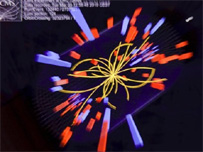
Experiments at the world's biggest atom smasher have yielded tantalizing hints that a long-sought sub-atomic particle truly exists, with final proof likely by late 2012, physicists said Monday.
Experiments at the world's biggest atom smasher have yielded tantalizing hints that a long-sought sub-atomic particle truly exists, with final proof likely by late 2012, physicists said Monday.
 "We know everything about the Higgs boson except whether it exists," said Rolf Heuer, director general of the European Organisation for Nuclear Research (CERN).
"We know everything about the Higgs boson except whether it exists," said Rolf Heuer, director general of the European Organisation for Nuclear Research (CERN).
"We can settle this Shakespearean question -- to be or not to be -- by the end of next year," he told journalists at a web-cast press conference at CERN headquarters in
Researchers at the US Department of Energy's Fermilab, meanwhile, also reported telltale signs of the elusive particle, heating up a longstanding rivalry between the two high-energy physics laboratories.
CERN and Fermilab have both reduced the range of mass within which the "God particle," as it is known, might be found to a fairly narrow, low-mass band.
"The search for the Higgs boson is entering its most exciting, final stage," Stefan Soldner-Rembold, spokesman for one of Fermilab's two key experiments, said last week in a statement.
Higgs or no Higgs, the stakes are huge either way, and could easily earn a Nobel Prize for the scientists who can take credit for the breakthrough.
The long-postulated particle, first proposed in 1964, is the missing cornerstone of an otherwise well-tested theory, called the Standard Model, which explains how known sub-atomic elements in the universe interact.
Without the 'God particle', however, that whole edifice falls apart because the Standard Model fails to answer one fundamental question: why do most elementary particles have mass?
British theoretical physicist Peter Higgs proposed a mechanism that would "save" the theory -- if the particle named for him truly exists.
"If you find the Boson Higgs, the Standard Model is complete. If you don't find it, then the Model has a serious problem. Both outcomes are discoveries," Heuer said.
The Large Hadron Collider (LHC) -- a 27-kilometre (16.9-mile) ring-shaped tunnel 100 metres (325 feet) below ground straddling the French-Swiss border -- was on track to crack the puzzle within 18 months, he said.
"The LHC is working beyond my expectations, as are the experiments" which, he added, are "now ready to bring us into unchartered territory."
Scientists have increased the amount of collisions delivered to the experiments by a factor of 20 over the last year, he noted.
The complex is designed to accelerate sub-atomic particles in opposite directions at nearly the speed of light and then smash them together, creating collisions that briefly stoke temperatures 100,000 times hotter than the Sun.
Researchers search the fleeting, sub-atomic rubble for clues to a host of unsolved mysteries about the origin and make-up of the universe.
"But don't expect too much too quickly," Heuer cautioned. "We are a factor of ten away from [the collision force] we hope to have at the end of next year. We are just in the middle," he said.

 Previous page
Previous page Back to top
Back to top







